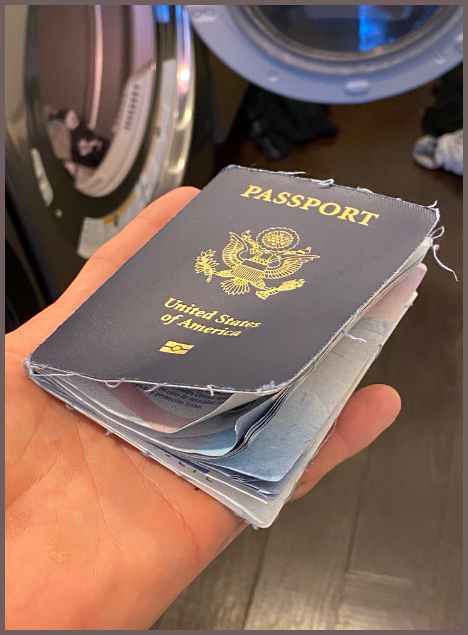We’ve all been there: you find that one sock you’ve been searching for all week, only to realize it’s been hiding in the darkest corners of your washing machine. Most of the time, this discovery is a sigh of relief, but what if the missing item isn’t a sock but your precious passport? In the whirlwind of life, accidents happen.
A passport washed in a washing machine can lead to a whole new set of challenges, and it’s essential to know how to handle this unfortunate mishap.
Table of Contents
The Horror Story: When Your Passport Takes a Spin
Imagine you’re preparing for an exciting international trip. You’ve got your tickets booked, your bags packed, and you’re counting down the days. But as you’re doing the last bit of laundry before departure, you hear a peculiar thud in the washer.
You open it up, only to find your passport soaked and spinning around with your clothes. Panic sets in. What now?
The Aftermath: Assessing the Damage

First things first, remain calm. A passport washed in a washing machine isn’t necessarily the end of the world. The damage to the passport will vary depending on the type of washing machine, the duration of the wash, and the temperature of the water.
The most common issue is that the ink on the passport’s pages becomes smudged, rendering the information difficult to read.
What Happens If I Accidentally Washed My Passport?
When a passport goes through the wash, the most significant risk is water damage to the biometric chip embedded in the document.
This chip contains essential personal information and is crucial for the passport’s functionality. If the chip is damaged, your passport may become invalid.
Can You Use a Passport That’s Been Through the Wash?
The answer to this question largely depends on the extent of the damage. In some cases, a washed passport may still be usable if the chip remains functional and the information is still legible.
However, it’s best not to take any chances, as border control agents may consider it a damaged passport and deny you entry or exit.
Can I Use a Water Damaged Passport?
A water-damaged passport may still be usable, but it’s not guaranteed. If the passport’s pages are warped, the ink is smudged, or the biometric chip is damaged, you might encounter problems while traveling.
It’s essential to evaluate the damage and consider applying for a new passport to avoid potential issues.
What Is Considered a Damaged Passport?
A damaged passport is any passport that is no longer in its original condition due to wear and tear, water exposure, or other factors that affect its appearance or functionality.
This includes passports with smudged ink, torn pages, or a nonfunctional biometric chip.
Salvaging the Situation: How to Dry a Washed Passport
How Do You Dry a Washed Passport?
If your passport has been washed, it’s essential to dry it as soon as possible. Gently dab the passport with a soft cloth or paper towel to absorb excess water. Avoid rubbing or applying pressure, as this can cause further damage.
Next, lay the passport on a flat surface and place a weight, like a heavy book, on top of it to help straighten the pages as they dry. Keep it in a well-ventilated area away from direct sunlight or heat sources.
Be patient and allow the passport to air dry completely before attempting to use it.
Read More: Why Do Hotels Need Your Passport?
How Can I Check If My Passport Is Damaged?
To check if your passport is damaged, first examine the physical condition of the document. Look for signs of water damage, smudged ink, or torn pages.
Next, verify if the biometric chip is still functional. You can do this by visiting an airport or other facility that has the appropriate equipment to scan the chip. They will be able to tell you if it’s still working.
If you’re unsure about the extent of the damage or whether your passport is still valid, it’s best to contact your country’s passport authority for guidance.
Dealing with the Aftermath: Replacing a Damaged Passport
If you’ve determined that your passport is damaged beyond repair, it’s time to apply for a replacement. The process for replacing a damaged passport will vary depending on your country of citizenship.
Generally, you’ll need to gather the necessary documentation, such as proof of citizenship and identification, along with your damaged passport. You may also be required to provide a written explanation of how the passport was damaged.
Contact your country’s passport authority for specific instructions on replacing a damaged passport.
Keep in mind that replacing a damaged passport can take several weeks or even longer, depending on the processing times.
If you have upcoming travel plans, it’s crucial to act quickly and consider expedited services if they are available.
Preventing Future Passport Laundry Disasters
To avoid another “passport washed in washing machine” scenario, consider implementing the following preventative measures:
- Store your passport securely
Keep your passport in a designated spot, such as a drawer or a safe, when you’re not using it. This can help prevent it from accidentally ending up in a laundry pile.
- Invest in a passport cover
A waterproof passport cover can protect your passport from water damage and make it easier to spot, reducing the chances of it getting mixed in with your laundry.
- Make a habit of checking pockets
Before doing laundry, take a moment to check all pockets for any important items, such as passports, wallets, or keys.
FAQ
Accidentally washing your passport can result in water damage to the pages and the biometric chip. Depending on the extent of the damage, your passport may no longer be valid.
It depends on the severity of the damage. If the chip is still functional and the information is legible, you might be able to use the passport. However, it’s best to avoid taking any risks, as border control agents may consider it a damaged passport and deny you entry or exit.
A water-damaged passport may still be usable, but it’s not guaranteed. If the passport’s pages are warped, the ink is smudged, or the biometric chip is damaged, you might encounter problems while traveling. It’s best to evaluate the damage and consider applying for a new passport to avoid potential issues.
A damaged passport is any passport that is no longer in its original condition due to wear and tear, water exposure, or other factors that affect its appearance or functionality. This includes passports with smudged ink, torn pages, or a nonfunctional biometric chip.
To dry a washed passport, gently dab it with a soft cloth or paper towel to absorb excess water. Lay the passport on a flat surface and place a weight on top to help straighten the pages as they dry. Keep it in a well-ventilated area away from direct sunlight or heat sources and allow it to air dry completely.
To check if your passport is damaged, examine the physical condition of the document for signs of water damage, smudged ink, or torn pages. Verify if the biometric chip is functional by visiting an airport or other facility that has the appropriate equipment to scan the chip. If you’re unsure about the extent of the damage or whether your passport is still valid, contact your country’s passport authority for guidance.
Conclusion
A “passport washed in washing machine” situation can cause stress and panic, but it’s essential to remain calm and assess the damage. Depending on the extent of the damage, your passport may still be usable, but it’s best to err on the side of caution and consider applying for a new one to avoid potential travel issues. By following the tips provided in this article, you can take the necessary steps to salvage or replace your damaged passport and prevent future laundry mishaps.
Always remember to store your passport securely, invest in a protective cover, and check pockets before doing laundry. By taking these precautions, you can ensure that your passport remains safe and ready for your next adventure.






